Climbing
The Everest Expedition: South Col Route
“Getting to the top is optional. Getting down is mandatory.” – Ed Viesturs
The Everest Expedition: South Col Route
I will be taking the South Col Route, from Nepal side for the expedition, landing in Kathmandu on Friday, 5th April 2024. It’ll be a 2-month long expedition.
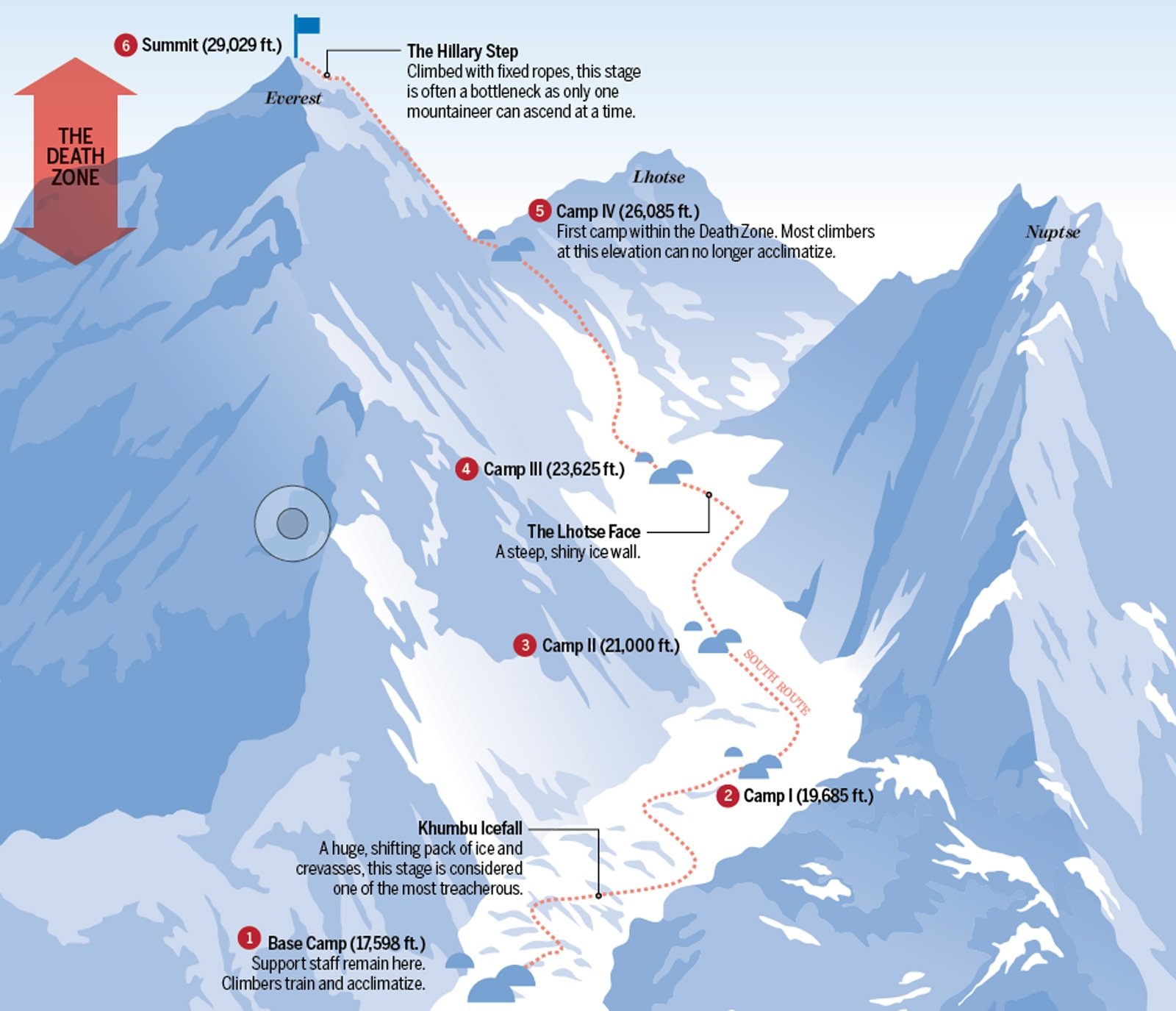
Elevation and Time Between Camps:
There are 5 Camps along the route, with various conditions, features, challenges in between:
- Base Camp (5,364 m/17,598 ft)
- Camp 1 (6,065 m/19,000 ft) | 2.6 km, 3-6 hrs
- Camp 2 (6,400 m/21,000 ft) | 2.8 km, 2-3 hrs
- Camp 3 (7,163 m/23,500 ft) | 2.6 km, 3-7 hrs
- Yellow Band: 1-3 hrs
- Geneva Spur: 1-2 hrs
- Camp 4/South Col (7,950 m/26,085 ft) | 1 hr
- South Summit (8,690 m/28,500 ft) | 3-5 hrs
- Hillary Step: 1 hr or less
- Summit (8,848 m/29,031 ft) | 1 hr or less
- Return to Camp 4: 3-7 hrs
- Return to Camp 2: 3 hrs
- Return to Base Camp: 4 hrs
BC – C4: O2 levels < 50%
Summit: O2 levels 33%
Walk to the Base Camp: Lukla (2,860 m/9,400 ft) to Everest Base Camp (5,364 m/17,598 ft): 65 Km | 8 Days |
I will start from Kathmandu on 8th April ’24, drive 4 hours to Ramechhap and fly (a short 30-min) into Nepal’s Khumbu Valley at Lukla, which incidentally is one of the world’s most dangerous airports with a very very short runway on a cliff ending into a deep valley. If we survive this then The walk to the Base Camp (BC) starts from here. It takes eight days including two days of acclimatisation. The Khumbu is incredibly beautiful and provides the opportunity to really immerse oneself in Sherpa culture, and the trek to base camp travels through several remote mountain locales along the way.
Check out my (trying to be funny) account of my first time (in 2011) on this trail. Since, then I have been here two times (2017 & 2019) leading teams.
Everest Base Camp Trek: A sneak “peak”
At the Base Camp: The Vibe, Training and Acclimatisation
The Base Camp itself is on the Khumbu Glacier, which is a slow moving mass of ice. So, don’t be surprised if you sleep in your tent in one direction and wake up in another. (Ok, maybe not that extreme, but you do get the “drift”).
BC would have some 400-500 climbers from all over the world and similar no. of sherpas and support staff. There is music, WiFi, food (entire world cuisine), beverages (Yes, that too!) and much more.
It’s a big party!!!
Talk about finding some peace in the mountains 😀
After all the fun and frolic, the real work of climbing to the summit starts.
It starts with the traditional Puja ceremony, that is officiated by 2-3 Buddhist monks, asking the Gods for blessing and permission to walk on the mountain.
Training:
Most of the time in the expedition is spent waiting at BC. So, one does a bit of training in the initial phase, in terms of technical climbing skills involving ice climbing, crossing crevasses (using ladders), using jumars (ascenders) on the fixed line, avalanche awareness, walking with crampons, snow & ice craft, self-arrest and some more.
I have been exposed to all of these in my previous climbing expeditions, but it’ll help to practise these skills.
Acclimatisation:
Acclimatisation is THE most important aspect of this expedition. For that, one has to make multiple camp rotations – at least four times:
1. BC to Camp 1 and back to BC
2. BC to Camp 1 (sleep 1-2 nights) and back to BC
3. BC to Camp 1 to Camp 2 (sleep 1-2 nights) and back to BC
4. BC to Camp 1 to Camp 2 to camp 3 (sleep 1 night, if possible) and back to BC
Sometimes, one goes below the base camp to as low as Pheriche (4,371 m/14,340 ft) for better acclimatisation.
I plan to summit Lobuche East peak (6,119 m/20,075 ft) before the rotations. That’ll help practise the technical skills and the necessary acclimatisation to skip the first rotation.
Base Camp to Camp 1:
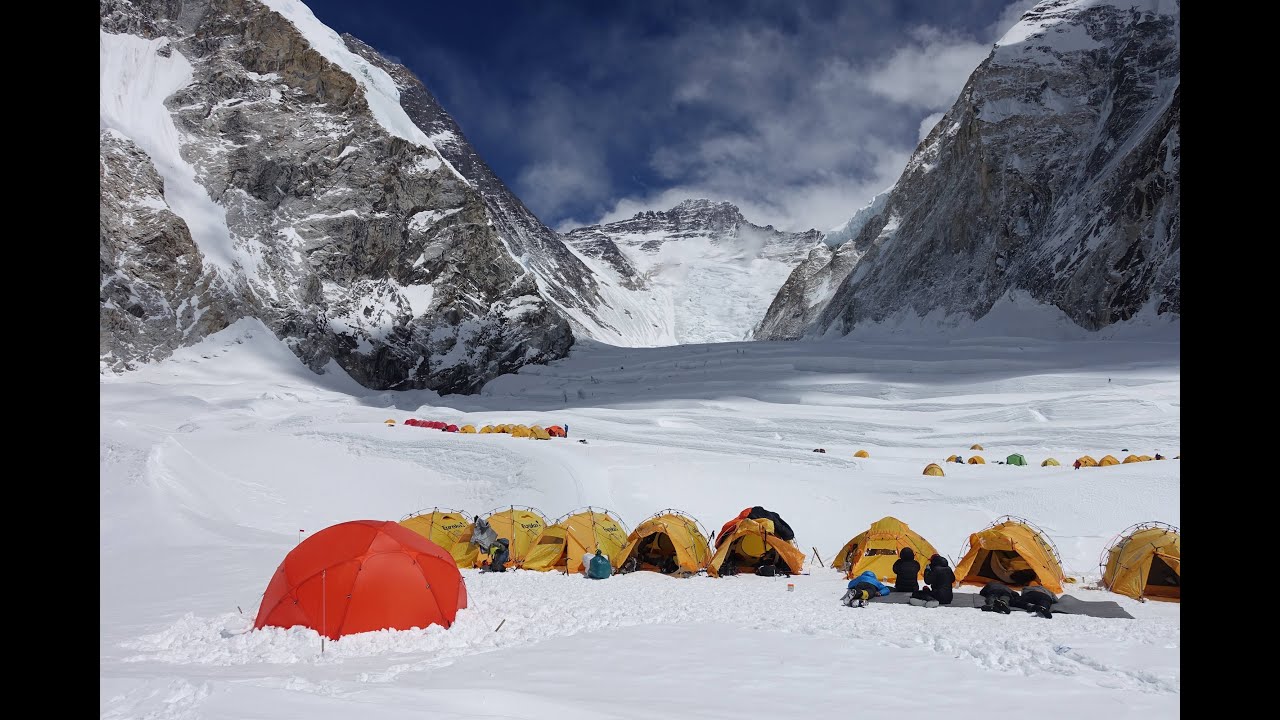
Just above the Base Camp is the Khumbu Icefall, the major obstacle of this route.
The Ice Fall is a 2,000 foot climb on an ever-moving glacier. This is one of the most dangerous stages of the South Col route, with ever-changing crevasses and possible falling of seracs (weighing tons)
Camp 1 to Camp 2:
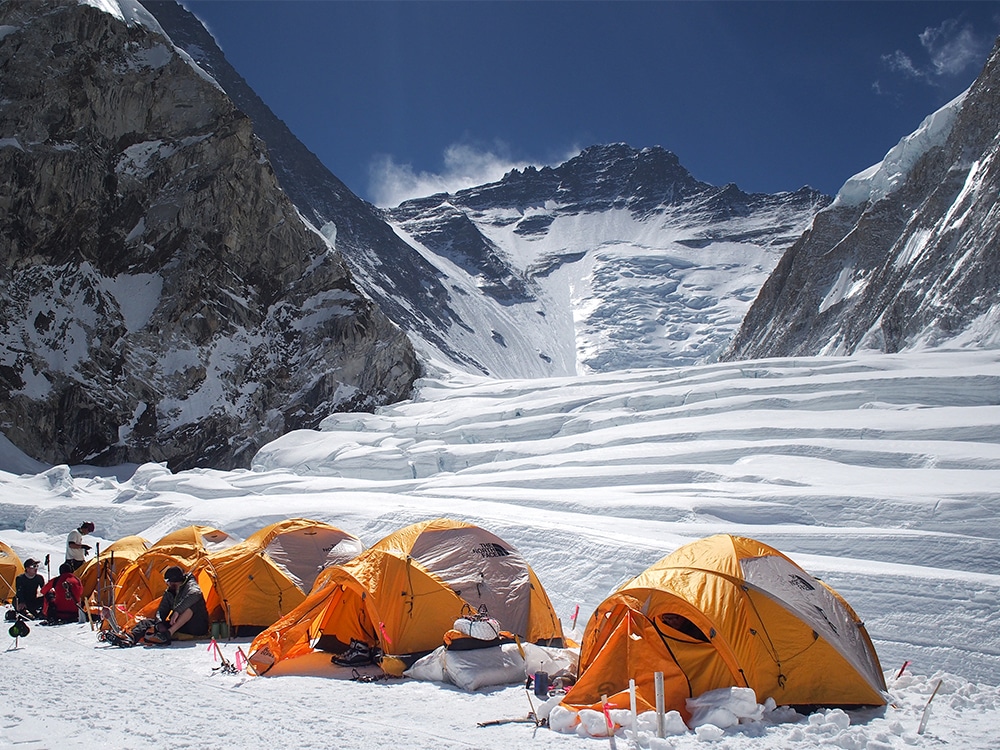
Western Cwm route from Camp 1 (top triangle) to Camp 2 (bottom triangle) as seen from Camp 3 on the Lhotse Face. This area is heavily crevassed and smart teams rope up or always stay clipped into the fixed rope. The Cwm is a ‘U’ shaped valley carved out by the Khumbu glacier. The reflection of the sun makes it very hot here and then there are crevasses. It takes about 2-3 hours to walk from C1 to C2 and it can be extremely hot. 2-3 hours, 2.8 km one way
Camp 2 to Camp 3:
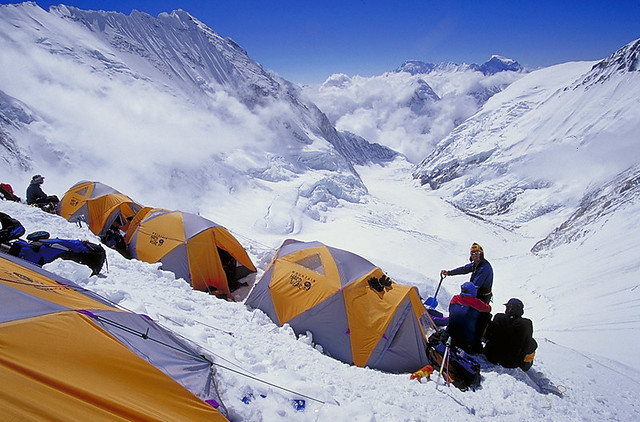
Route from Camp 3 to Camp 4 up the Lhotse Face, across the yellow band and up the Geneva Spur to the South Col. Climbers must be clipped into the fixed line at all times to avoid falling resulting in injury or death. 3-6 hours, 2.6 km one way.
Camp 3 to Camp 4:
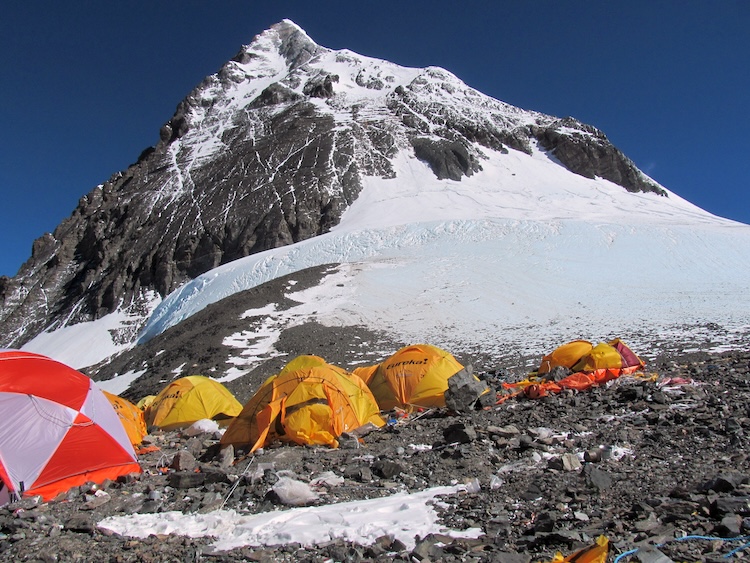
Route from Camp 3 to the Camp 4/South Col. Across the Yellow Band and to the left up the Geneva Spur. This is the first time most climbers start to use bottled oxygen. And they start wearing the warm down suits in anticipation of the cold and heavy winds in Camp 4 and above. The climbing and Yellow Band is not technically hard but climbers are approaching 8,000m. 3-6 hours, 1.5 km one way.
Yellow Band is a sedimentary sandstone rock and is a distinctive feature of the Lhotse Face which requires about 100 meters of rope to traverse it.
Geneva Spur is a large rock buttress near the summits of Everest and Lhotse. It is above Camp 3 and the Yellow Band, but before Camp 4.
Camp 4 to the Summit and back to Camp 4: 15-17 hrs
After reaching Camp 4, the climbers typically rest, breathing bottled O2 throughout. Around 10 pm the summit push starts fro some even earlier.
In around 3-4 hrs, they reach the balcony. It’s a flat area where one rests, leave the extra bottled oxygen to be used on the way back. From the balcony, one climbs to the South Summit. After descending from South Summit one encounters a knife-edge ridge, the Cornice Traverse, which leads the Hillary Step, a major technical section before the summit.
It takes one hour to cross Hillary Step and another hour to reach the top 
But it’s not over yet.
Camp 4 to Camp 2: 3 hrs
Return to Base Camp: 4 hrs
->Back to: My upcoming journey to Mt. Everest

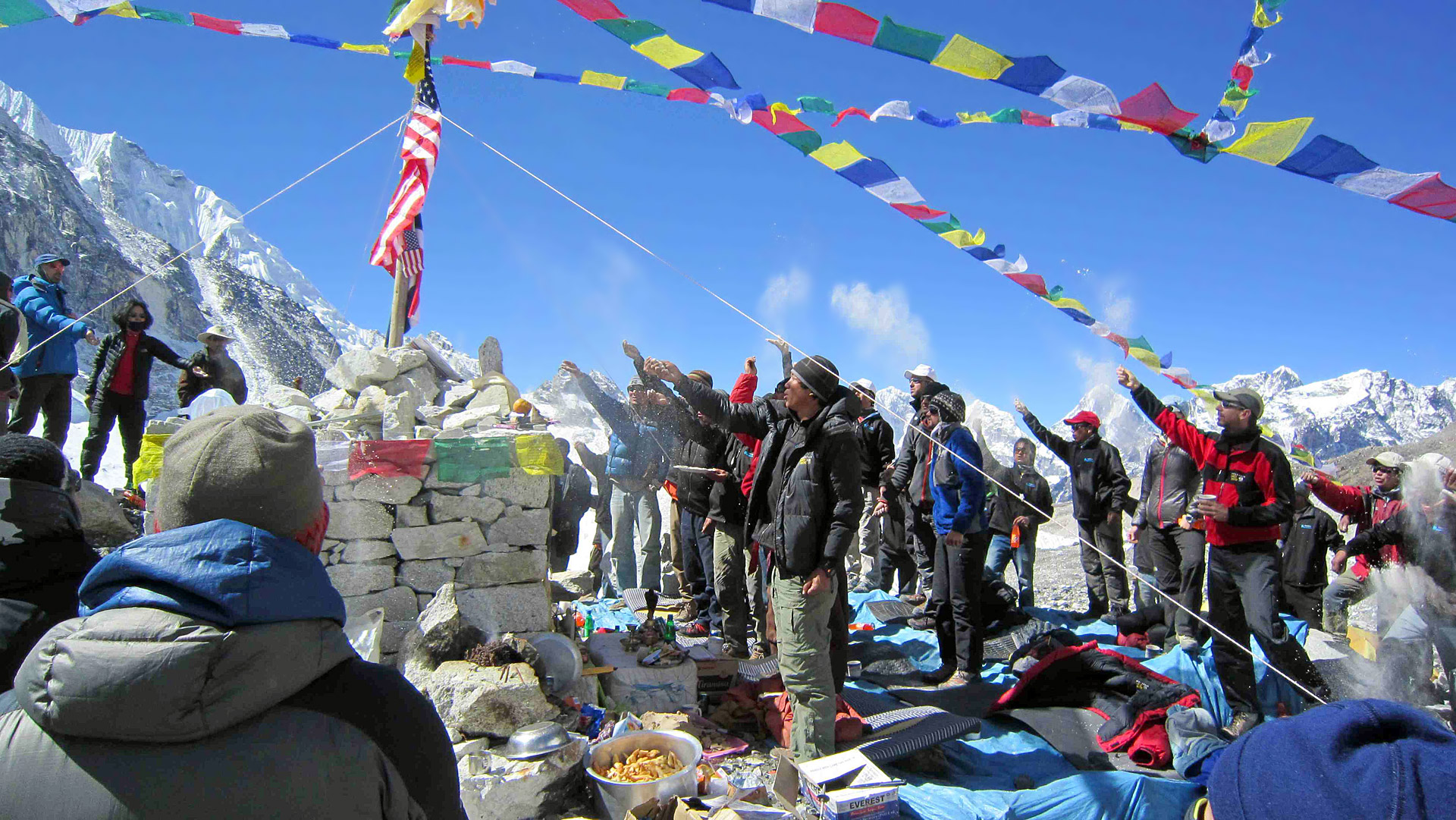
 Follow
Follow








